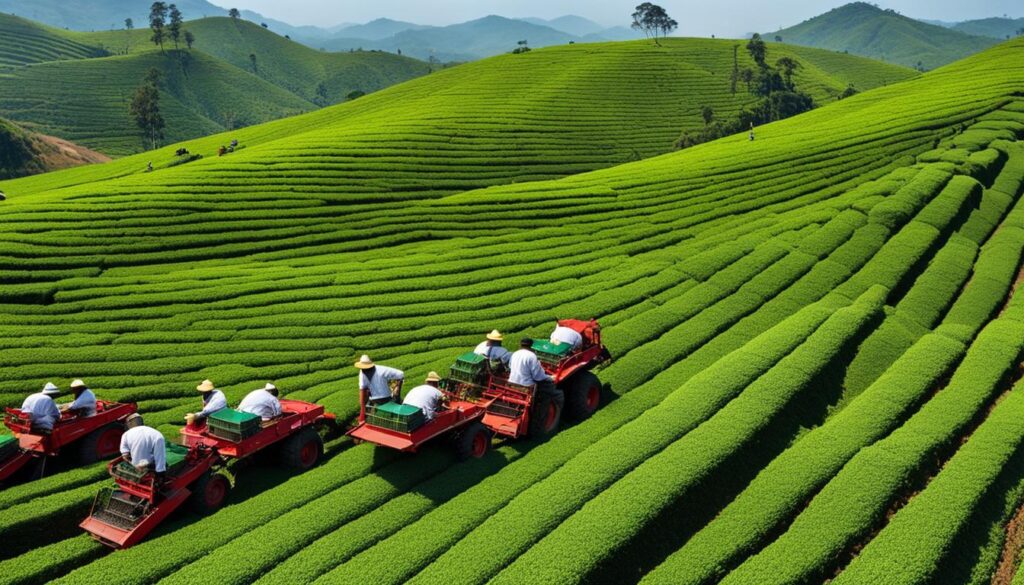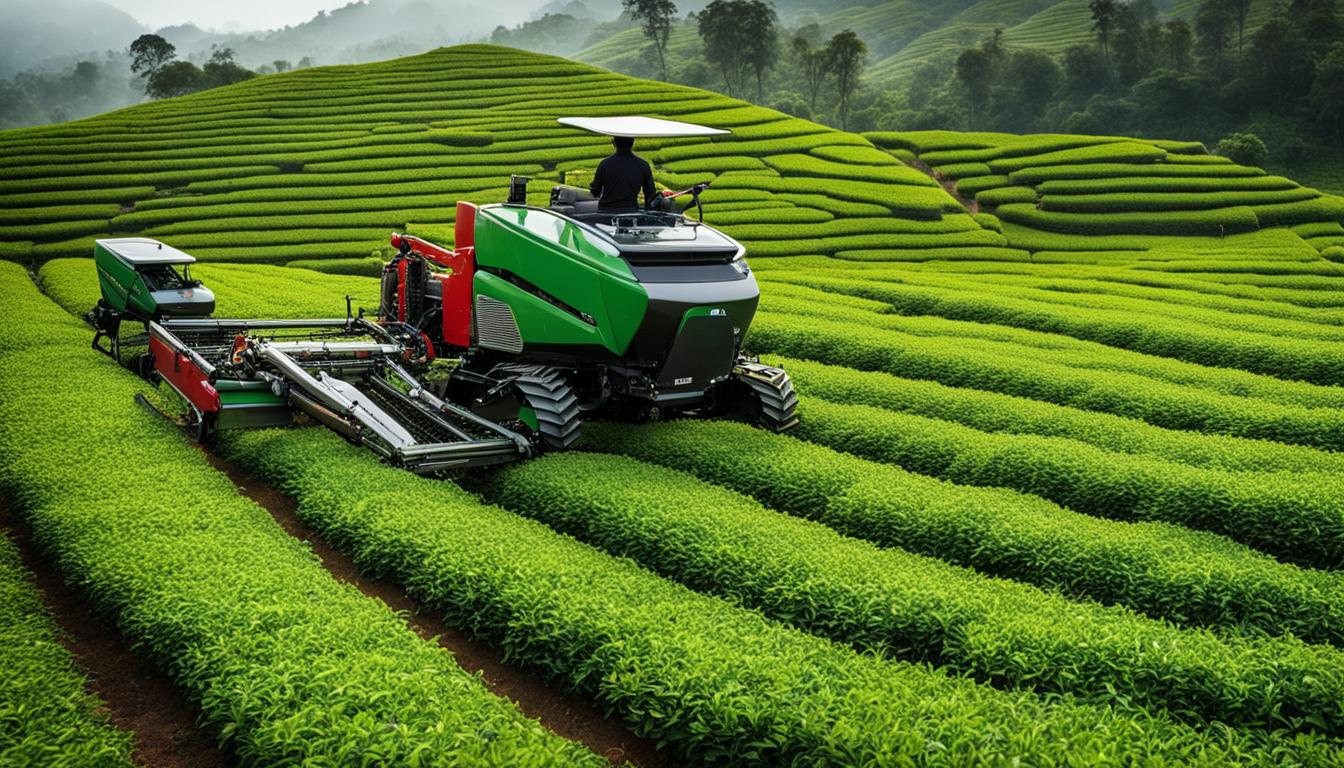In recent years, we have witnessed significant advancements in the tea industry, with tea producers embracing mechanized methods for harvesting tea. Gone are the days of labor-intensive hand plucking. Today, robotic tea harvesting machines and other mechanized techniques are revolutionizing tea production, bringing a plethora of benefits to the table.
By implementing mechanized tea harvesting methods, tea producers can improve both productivity and efficiency. These innovations have become the driving force behind the transformation of the tea industry, allowing it to overcome various challenges, such as low prices, labor shortages, and escalating costs.
So, what exactly are these mechanized tea harvesting methods? Well, they involve the use of motorized machines and mechanical aids to harvest tea bushes. In fact, it is estimated that over 70% of tea bushes worldwide are now harvested using mechanized techniques.
Now, let’s take a closer look at the numerous benefits that mechanized tea harvesting brings to the table.
Key Takeaways:
- Mechanized tea harvesting methods, including robotic machines, are revolutionizing the tea industry.
- These innovations improve productivity and efficiency, addressing challenges faced by tea producers.
- Over 70% of tea bushes globally are now harvested using mechanized techniques.
- Mechanized tea harvesting methods offer numerous benefits to tea producers.
- Stay tuned for the rest of our article to discover the economic advantages and impact on tea quality.
The Economics of Mechanized Tea Harvesting
In today’s tea industry, the shift towards mechanized tea harvesting methods has proven to be an economically advantageous choice. Compared to traditional hand plucking, mechanized harvesting offers increased efficiency and cost savings. Hand plucking accounts for 50 percent of the total cost of tea production, primarily due to the large workforce required. On the other hand, mechanized harvesting can significantly reduce labor expenses by up to 74-75 percent.
By adopting mechanized tea harvesting, tea producers can increase productivity and reduce the number of labor days required, resulting in substantial cost savings. These savings make tea production more financially viable for tea producers, allowing them to remain competitive in the market. Additionally, mechanized methods contribute to greater efficiency in tea processing, further enhancing cost-effectiveness.
| Mechanized Tea Harvesting vs. Traditional Hand Plucking | Efficiency | Cost Analysis |
|---|---|---|
| Mechanized Harvesting | Increases productivity by up to 74-75% | Reduces labor expenses |
| Traditional Hand Plucking | Relies on a large workforce | Accounts for 50% of total cost |
“Mechanized tea harvesting offers significant economic advantages over traditional hand plucking. By reducing labor expenses and increasing productivity, tea producers can achieve substantial cost savings and remain competitive in the market.”
With these economic advantages in mind, it is clear that mechanized tea harvesting is revolutionizing the tea industry. By embracing mechanization, tea producers can navigate the challenges of oversupply, low prices, and labor shortages. The adoption of mechanized methods ensures the sustainability and long-term viability of tea farming.
Mechanized Tea Harvesting and Quality: Ensuring Sustainability
One common concern surrounding mechanized tea harvesting is its potential impact on tea quality. Many tea enthusiasts worry that the use of machines may compromise the flavor, aroma, and overall sensory experience of the tea. However, with the right adjustments in processing techniques and management practices, mechanized harvesting can actually contribute to the improvement of tea quality.
By utilizing robotic tea harvesting machines and other mechanized methods, it is possible to ensure the selection of mature tea shoots while avoiding the inclusion of maintenance foliage. This careful selection process results in a higher standard of green leaf, which is crucial for producing high-quality tea. While commodity tea may tolerate lower quality standards due to its lower pricing, specialty tea producers can maintain stringent quality control measures and even command premium prices.
Moreover, mechanized tea harvesting can also contribute to the sustainability of the tea industry. By incorporating sustainable practices into mechanized tea farming, producers can reduce the environmental impact associated with traditional hand plucking. For example, mechanized harvesting reduces the need for large labor forces, minimizing carbon emissions from transportation and lowering the overall ecological footprint of tea production.
The Benefits of Sustainable Mechanized Tea Harvesting
There are several advantages to adopting sustainable mechanized tea harvesting methods. Firstly, it allows for greater efficiency and productivity in tea production, ensuring that tea farmers can meet the increasing global demand for their products. Secondly, by reducing labor expenses, mechanization helps tea producers to maintain competitiveness in the market and potentially increase profitability. Lastly, sustainable mechanized tea farming contributes to the preservation of natural resources and biodiversity, promoting a more environmentally conscious approach to agriculture.
| Benefits of Sustainable Mechanized Tea Harvesting: | Impact: |
|---|---|
| Improved tea quality | Enhanced sensory experience for consumers |
| Increased productivity | Meets global demand for tea |
| Reduced labor expenses | Enhances financial viability for tea producers |
| Environmental conservation | Preserves natural resources and biodiversity |
In conclusion, mechanized tea harvesting, when implemented sustainably and with careful attention to processing techniques, can maintain and even improve the quality of tea. By embracing this innovative approach, tea producers can strike a balance between efficiency, productivity, and environmental sustainability. The future of tea farming lies in the adoption of mechanized methods, ensuring a prosperous and sustainable tea industry for years to come.
Innovations in Mechanized Tea Harvesting Technology
Technological advancements in mechanized tea harvesting have revolutionized the tea industry, enabling large-scale production and efficient tea leaf processing. These innovations have brought about significant improvements in productivity, cost-effectiveness, and overall quality. Let’s explore some of the groundbreaking technologies that are shaping the future of mechanized tea farming:
Williames’ Selective Tea Harvester
One remarkable innovation in mechanized tea harvesting is the Williames’ Selective Tea Harvester. This cutting-edge machine incorporates a patented system that selectively harvests mature shoots while avoiding undersized shoots and maintenance foliage. By ensuring the collection of high-quality tea leaves, this technology has become a game-changer for tea producers. The Williames’ Selective Tea Harvester has been successfully adopted by tea farms worldwide, improving efficiency, reducing labor costs, and maintaining exceptional standards of tea quality.
Additionally, the adoption of modern field management practices has further enhanced large-scale mechanized tea production. Advanced machinery and equipment have streamlined tea leaf processing, allowing for efficient sorting, grading, and packaging. With these innovations, tea producers can now achieve higher yields, faster production cycles, and improved consistency in tea quality.

The Future of Mechanized Tea Farming
As the tea industry continues to evolve, the adoption of mechanized tea farming methods is poised to play a crucial role in its sustainability and growth. These innovations offer tea producers a means to overcome challenges such as labor shortages, rising costs, and increasing demand. With ongoing research and development, the future of mechanized tea farming looks promising, ensuring a thriving and competitive tea industry for years to come.
Table: Comparative Analysis of Mechanized Tea Harvesting
| Traditional Hand Plucking | Mechanized Tea Harvesting | |
|---|---|---|
| Labor Expenses | High | Reduced |
| Productivity | Lower | Higher |
| Tea Quality | Dependent on skilled pluckers | Consistently high |
| Cost-effectiveness | Lower | Higher |
By embracing mechanized tea harvesting technology, tea producers can optimize their operations and achieve greater efficiency, cost-effectiveness, and quality. These innovations are transforming the tea industry, paving the way for sustainable and prosperous mechanized tea farming.
Conclusion
As we have explored in this article, the advent of mechanized tea harvesting methods has revolutionized the tea industry. Not only do these methods offer economic advantages in terms of increased productivity and reduced labor costs, but they also hold the potential to enhance the overall quality of tea production.
Contrary to common concerns, mechanized tea harvesting does not compromise tea quality. With the right adjustments in processing techniques and management practices, tea producers can ensure that only the finest, mature shoots are selected, resulting in a high standard of green leaf. This is particularly important for specialty tea producers who aim to maintain premium quality and command higher prices.
Furthermore, embracing sustainable practices in mechanized tea farming can contribute to long-term environmental conservation. By minimizing waste and optimizing resource usage, tea producers can promote the sustainability of the industry and secure its future.
In conclusion, mechanized tea harvesting methods, supported by ongoing research and development, offer a promising future for the tea farming industry. By leveraging technological advancements, implementing sustainable practices, and preserving the artistry of hand plucking in specialty tea production, we can ensure a prosperous and sustainable future for mechanized tea farming.
FAQ
Does mechanized tea harvesting compromise the quality of the tea?
No, with the right adjustments in processing techniques and management practices, mechanized harvesting can actually improve tea quality. By ensuring the selection of mature shoots and avoiding the inclusion of maintenance foliage, mechanized harvesters can deliver a high standard of green leaf.
What are the economic advantages of mechanized tea harvesting?
Mechanized harvesting offers significant cost savings compared to traditional hand plucking. It can increase productivity by up to 74-75 percent, reducing labor expenses and making tea production more financially viable for tea producers.
How are mechanized tea harvesting methods contributing to sustainability?
By incorporating sustainable mechanized tea harvesting methods, tea producers can contribute to environmental conservation and long-term sustainability.
What technological innovations have emerged in mechanized tea harvesting?
One notable example is the Williames’ Selective Tea Harvester, which selectively harvests mature shoots while avoiding undersized shoots and maintenance foliage. Other advancements in machinery and equipment, as well as the adoption of modern field management practices, have also enabled large-scale mechanized tea production and streamlined tea leaf processing.
How can tea producers overcome the challenges they face?
By embracing mechanized tea harvesting methods and implementing sustainable practices, tea producers can increase productivity, reduce labor costs, and secure the future of the tea industry.





